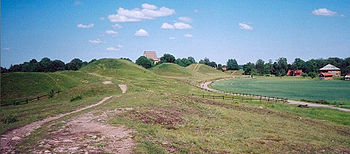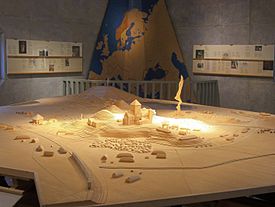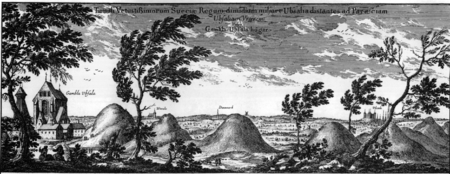- Gamla Uppsala
-
Gamla Uppsala ("Old Uppsala") is a parish and a village outside Uppsala in Sweden. It had 16,231 inhabitants in 1991.
As early as the 3rd century AD and the 4th century AD and onwards, it was an important religious, economic and political centre.[1] Early written sources show[clarification needed] that already during pre-history, Gamla Uppsala was well known in Northern Europe as the residence of the Swedish kings of the legendary Yngling dynasty.[2] In fact, the oldest Scandinavian sources, such as Ynglingatal, the Westrogothic law and the Gutasaga talk of the king of Sweden as the "King at Uppsala".[3]
During the Middle Ages, it was the largest village of Uppland, the eastern part of which probably originally formed the core of the complex of properties belonging to the Swedish Crown, the so called Uppsala öd, of which the western part consisted of the royal estate itself, kungsgården.[4]
It was also the location of the Thing of all Swedes which was a thing (general assembly) held from pre-historic times to the Middle Ages, at the end of February or early March.[5] It was held in conjunction with a great fair called Disting, and a pagan celebration called Dísablót.[6][7] The Law of Uppland informs that it was at this assembly that the king proclaimed that the leidang would be summoned for warfare during the summer, and all the crews, rowers, commanders and ships were decided.[8]
It was not only the pagan cultic centre, it also became Sweden's archbishopric in 1164.[9]
Contents
Geographical description
Gamla Uppsala lies on Fyris Wolds, a cultivated plain in the valley of the River Fyris which is densely populated in its southern part, while the northern part consists of farms.
Religious importance
Medieval Scandinavians held Gamla Uppsala to one of the oldest and most important locations in Scandinavia. The Danish chronicler Saxo Grammaticus held Odin himself to have resided in Gamla Uppsala far back in the mists of time:
- At this time there was one Odin, who was credited over all Europe with the honour, which was false, of godhead, but used more continually to sojourn at Uppsala; and in this spot, either from the sloth of the inhabitants or from its own pleasantness, he vouchsafed to dwell with somewhat especial constancy.[10]
This tradition was also known by the Icelandic historian Snorri Sturluson, who, however had Odin reside in nearby Fornsigtuna, whereas the god Freyr lived in Gamla Uppsala.[11] Freyr is also said to have founded two of the central institutions of Iron Age Sweden, the Uppsala öd and the Temple at Uppsala:
- Frey took the kingdom after Njord, and was called drot by the Swedes, and they paid taxes to him. He was, like his father, fortunate in friends and in good seasons. Frey built a great temple at Uppsala, made it his chief seat, and gave it all his taxes, his land, and goods. Then began the Upsal domains, which have remained ever since.[11]
Saxo Grammaticus adds that Freyr began the human sacrifices at Gamla Uppsala:
- Also Frey, the regent of the gods, took his abode not far from Uppsala, where he exchanged for a ghastly and infamous sin-offering the old custom of prayer by sacrifice, which had been used by so many ages and generations. For he paid to the gods abominable offerings, by beginning to slaughter human victims.[12]
The sacrifices at the Temple at Uppsala are described through an eye-witness account by Adam of Bremen:
- At this point I shall say a few words about the religious beliefs of the Swedes. That nation has a magnificent temple, which is called Uppsala, located not far from the city of Sigtuna. In this temple, built entirely of gold, the people worship the statues of three gods.[13]
- A general festival for all the provinces of Sweden is customarily held at Uppsala every nine years. Participation in this festival is required of everyone. Kings and their subjects, collectively and individually, send their gifts to Uppsala; - and – a thing more cruel than any punishment – those who have already adopted Christianity buy themselves off from these ceremonies. The sacrifice is as follows; of every kind of male creature, nine victims are offered. By the blood of these creatures it is the custom to appease the gods. Their bodies, moreover, are hanged in a grove which is adjacent to the temple. This grove is so sacred to the people that the separate trees in it are believed to be holy because of the death or putrefaction of the sacrificial victims. There even dogs and horses hang beside human beings. (A certain Christian told me that he had seen seventy-two of their bodies hanging up together.) The incantations, however, which are usually sung in the performance of a libation of this kind are numerous and disgraceful, and it is better not to speak of them.[13]
In the scolia, there is an additional description:
- Near that temple is a very large tree with widespread branches which are always green both in winter and summer. What kind of tree it is nobody knows. There is also a spring there where the pagan are accustomed to perform sacrifices and to immerse a human being alive. As long as his body is not found, the request of the people will be fulfilled. A golden chain encircles that temple and hangs over the gables of the building. Those who approach see its gleam from afar off because the shrine, which is located on a plain, is encircled by mountains so situated as to give the effect of a theatre. For nine days feasts and sacrifices of this kind are celebrated. Every day they sacrifice one human being in addition to other animals, so that in nine days there are 72 victims which are sacrificed. This sacrifice takes place about the time of the vernal equinox.[13]
It was a symbolic moment when Pope John Paul II visited Scandinavia in 1989 and held an open-air mass at the royal mounds in Gamla Uppsala, as this was a pagan cultic centre, which became Sweden's first archbishopric in 1164.[14]
In 2000, the Swedish AsatruSociety restarted the tradition of holding blóts at Gamla Uppsala.[citation needed]
The 16th-century Archbishop of Uppsala Johannes Magnus asserted that the city was anciently founded by, and named for, an early Swedish king named Ubbo (Uppsala = Ubbo's Hall), who would have supposedly reigned ca. 2300 BC. However, in the absence of any corroborating evidence, Magnus' accounts no longer enjoy widespread acceptance among scholars today.
History
It is a testimony to the sanctity of the location in the mindset of medieval Norse pagans that Gamla Uppsala was the last stronghold of pagan Germanic kingship. During the 1070s and 1080 there appears to have been a pagan renaissance with the magnificent Temple at Uppsala described in a contested account through an eye-witness by Adam of Bremen. Adam of Bremen relates of the Uppsala of the 1070s and describes it as a pagan cult centre with the enormous Temple at Uppsala containing wooden statues of Odin, Thor and Freyr.
Sometime in the 1080s the Christian king Ingi was exiled for refusing to perform the sacrifices. Instead Blot-Sweyn was elected, but he was killed by Ingi who could then reclaim his throne.
It is a testimony of Gamla Uppsala's great importance in Swedish tradition, that when Sweden received its Archbishopric in 1164, it was located in Gamla Uppsala. In practice, it had, however, lost its strategic importance due to the constant land elevation.
Archaeology
People have been buried in Gamla Uppsala for 2,000 years, since the area rose above water. Originally there were between 2,000 and 3,000 mounds in the area but most have become farmland, gardens and quarries. Today only 250 barrows remain.
In the parish there are more than 1,000 preserved archaeological remains, but many more have been removed by agriculture. There are cairns of splintered stone that reveal that the area was settled during the Nordic Bronze Age, but most of the grave fields are from the Iron Age and the Viking Age.
The great grave field south of the Royal Mounds is from the Roman Iron Age and the Germanic Iron Age. Near the vicarage, a few unburnt graves from the Viking Age have been excavated.
Under the present church in Gamla Uppsala have been found the remains of one or several large wooden buildings. Some archaeologists believe that they are the remains of the Temple of Uppsala, while others hold that comes from an early Christian wooden church. Churches were often built on pre-Christian sacred sites, though.
Adjacent to the present church there is a plateau of clay, the Plateau of the Royal Estate (Kungsgårdsplatån), on which archaeologists have found the remains of a large hall.
The Royal Mounds
The Royal mounds (Swedish: Kungshögarna) is the name for the three large barrows which are located in Gamla Uppsala. According to ancient mythology and folklore, it would be the three gods Thor, Odin and Freyr lying in Kungshögarna or Uppsala högar (from the Old Norse word Haugr meaning mound or barrow).[15] In the 19th and 20th centuries, they were speculated to hold the remains of three kings of the legendary House of Ynglings and where thus known by the names Aun's Mound, Adil's Mound and Egil's Mound. Today their geographical locations are instead used and they are called the Eastern mound, Middle Mound and Western Mound.
They are dated to the 5th and 6th centuries. As Sweden's oldest national symbols they are even depicted on the covers of books about the Swedish national identity. In the 6th century, Gamla Uppsala was the location of royal burials. The location was chosen carefully and in order to make them majestic. The tumuli were constructed on top of the ridge.
By burning the dead king and his armour, he was moved to Valhalla by the consuming force of the fire. The fire could reach temperatures of 1500 °C. The remains were covered with cobblestones and then a layer of gravel and sand and finally a thin layer of turf.
- Thus he (Odin) established by law that all dead men should be burned, and their belongings laid with them upon the pile, and the ashes be cast into the sea or buried in the earth. Thus, said he, every one will come to Valhalla with the riches he had with him upon the pile; and he would also enjoy whatever he himself had buried in the earth. For men of consequence a mound should be raised to their memory, and for all other warriors who had been distinguished for manhood a standing stone; which custom remained long after Odin's time. [...] It was their faith that the higher the smoke arose in the air, the higher he would be raised whose pile it was; and the richer he would be, the more property that was consumed with him. (Ynglinga saga)
An old controversy and its solution
In the 1830s, some scholars claimed that the mounds were pure natural formations and not barrows. This affront to ancient Swedish national symbols could not be accepted by the future Swedish king Karl XV and in order to remove any doubt, he decided to start an excavation.
The task was given to Bror Emil Hildebrand, the director-general of the National Archives. In 1846, he undertook the excavation of the nine metres tall Eastern mound with the hope of finding the grave of a Swedish king of old.
The eastern mound
The excavation was complex and generated a lot of publicity. A 25-metre long tunnel was dug into the mound, where they found a pot of clay filled with burnt bones and around it there were the remains of the charred grave offerings.
Among the most important finds in the eastern mound were many fragments of decorated bronze panels with a dancing warrior carrying a spear. These panels have probably adorned a helmet of the Vendel Age type, common in Uppland (the only foreign example being the one in Sutton Hoo). There were also finds of gold which probably had adorned a scramasax, but according to another interpretation, they were part of a belt. The dead was also given several glass beakers, a tafl game, a comb and a hone.
Most scholars agree that the mound was either raised for a woman or for a young man and a woman[why?], but as Hildebrand reburied most of the remains, a new excavation is to be undertaken before the controversy can be settled. What is quite certain is that the dead belonged to a royal dynasty.
The western mound
In 1874, Hildebrand started an excavation of the western mound and opened an enormous shaft right into the cairn in the centre of the mound. Under the cobble stones, there were the charred remains of the funeral fire.
In the western mound were found the remains of a man and animals, probably for food during the journey. The remains of a warrior equipment were found. Luxurious weapons and other objects, both domestic and imported, show that the buried man was very powerful. These remains include a Frankish sword adorned with gold and garnets and a board game with Roman pawns of ivory. He was dressed in a costly suit made of Frankish cloth with golden threads, and he wore a belt with a sumptuous buckle. There were four cameos from the Middle East which were probably part of a casket. The finds show the distant contacts of the people of Uppland in the 6th century.
The church
The church was the Archbishopric of Sweden prior to 1273, when the archbishopric was moved to Östra Aros (Östra Aros was then renamed Uppsala due to a papal request). The old cathedral was probably built in the 11th century, but finished in the 12th century. The stone building may have been preceded by a wooden church and probably by the large Temple at Uppsala. After a fire in 1240, the nave and transepts of the cathedral were removed leaving only the choir and central tower, and with the addition of the sacristy and the porch gave the church its present outer appearance. In the 15th century, vaults were added as well as chalk paintings. Among the medieval wooden sculptures there are three crucifixes from the 12th, 13th and 15th centuries. Valerius (Archbishop of Uppsala) is buried here. Eric IX of Sweden was as well, before being moved to Uppsala Cathedral.
Notes
- ^ Hadenius, Stig; Nilsson, Torbjörn & Åselius, Gunnar. (1996). Sveriges historia. Centraltryckeriet, Borås. ISBN 91-34-51-857-6 p. 83:
Uppsala, från 200- och 300-talen ett betydande ekonomiskt, religiöst och politiskt centrum i Mälardalen [...]. Translation: Uppsala, was from the 3rd and 4th centuries an important economic, religious and political centre in the Mälaren basin [...]. - ^ The article Gamla Uppsala, subsection Historia, in Nationalencyklopedin (1992):
Tidiga skriftliga källor visar att G. redan under forntiden var vittberömt i Norden som säte för sveakungarna av den mytomspunna Ynglingaätten. & Translation: Early written sources show that G. as early as pre-historic times was widely famous in the Nordic countries as the residence of the Swedish kings of the legendary Yngling dynasty. - ^ Thunmark-Nylén, Lena (1995), "Gamla Uppsala", Vikingatidens ABC, Swedish Museum of National Antiquities, ISBN 9171929843, http://histvarld.historiska.se/histvarld/sok/artikel.asp?id=10358, retrieved 2007-08-09:
Svearikets kung omtalas som kungen i Uppsala bl a i Ynglingatal, Gutasagan och Äldre Västgötalagens bihang om gränsdragning. Translation: Sweden's king is mentioned as the king at Uppsala in for instance Ynglingatal, the Gutasaga and in the Westrogothic law's appendix on the establishment of the border. - ^ The article Gamla Uppsala, subsection Historia, in Nationalencyklopedin (1992):
Under medeltiden var G. Upplands största by, vars östra del ursprungligen torde ha bildat kärnan i det s.k. Uppsala öd, kronans godskomplex, och vars västra del utgjorde själva kungsgården. Translation: During the Middle Ages, G. was the largest village of Uppland, whose eastern part originally should have been the core of the so-called Uppsala öd, the complex of estates of the Crown, and whose western part consisted of the royal estate itself. - ^ Folin, Nina (2001), "Landsting", Medeltidens ABC, Swedish Museum of National Antiquities, ISBN 9151839261, http://histvarld.historiska.se/histvarld/sok/artikel.asp?id=20990
- ^ The article Disatinget, in the encyclopedia Nordisk familjebok
- ^ The article Disablot, in the encyclopedia Nordisk familjebok.
- ^ Söderberg, Werner. (1896). "Några studier rörande Disasagan", in Samlaren. p. 67.
- ^ "KG Hammar fick vänta", Kyrkans Tidning, nr 14, 2005.
- ^ Saxo Grammaticus: Gesta Danorum (book 1), translated by Oliver Elton, at the Online Medieval & Classical Library.
- ^ a b Snorri Sturluson: Ynglinga saga, translated by Samuel Laing, at Northvegr.
- ^ Saxo Grammaticus: Gesta Danorum (book 3), translated by Oliver Elton, at the Online Medieval & Classical Library.
- ^ a b c Adam of Bremen, History of Hamburg's Bishops, short online text. English.
- ^ "KG Hammar fick vänta", Kyrkans Tidning, May 14, 2005.
- ^ The temple of gold, or church of wood? Ground Radar Surveys at Old Uppsala Church. Magnus Alkarp, Fornvännen 2005
External links
- Virtual tour of Gamla Uppsala Church
- Archeological information Gamla Uppsala, by the Swedish National Heritage Board.
- Uppsala official site.
Coordinates: 59°53′37″N 17°38′16″E / 59.893695°N 17.637777°E
References
- Klingmark, Elisabeth: Gamla Uppsala, Svenska kulturminnen 59, Riksantikvarieämbetet.
- Nationalencyklopedin
- 59 53 53.58 N, 17 37 49.18 E - Sweden location of Gamla Uppsala, n. to Uppsala
Categories:- Archaeological sites in Sweden
- Medieval literature
- Saga locations
- History of the Germanic peoples
- Romanesque architecture in Scandinavia
- Viking Age populated places
Wikimedia Foundation. 2010.








